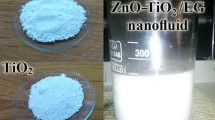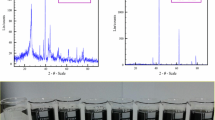Abstract
The thermal conductivity (TC) of DWCNT/EG nanofluid at the temperature range of 30–50 °C and solid volume fraction (SVF) range of 0.055–0.92% was investigated. The results showed that the enhancement of SVF at 50 °C increases TC up to 35.37%. Experimental data obtained for this nanofluid were compared with experimental results of SWCNT/EG, DWCNT–ZnO/EG–water (40:60), MWCNT–ZnO (50:50)/EG–water (50:50) and SWCNT–ZnO (30:70)/EG–water (60:40). Using experimental data, a correlation was proposed for the prediction of TC with R2 (regression coefficient) and maximum correlation error of 0.993687% and 2%, respectively. Nanofluid sensitivity analysis showed that in higher SVFs, the increment of sensitivity relative to temperature is higher than in lower SVFs.
Graphic Abstract















Similar content being viewed by others
Abbreviations
- K nf :
-
Thermal conductivity of nanofluid
- K f :
-
Thermal conductivity of base fluid
- R2 :
-
Regression coefficient
- T:
-
Temperature
- BET:
-
Brunauer–Emmett–Teller
- EG:
-
Ethylene glycol
- EXP:
-
Experimental
- MOD:
-
Margin of deviation
- DWCNT:
-
Double-walled carbon nanotube
- HT:
-
Heat transfer
- MWCNT:
-
Multi-walled carbon nanotube
- Pred:
-
Predicted
- SWCNT:
-
Single-walled carbon nanotube
- SVF:
-
Solid volume fraction
- SSA:
-
Specific surface area
- TEM:
-
Transmission electron microscopy
- PPF:
-
Price performance factor
- TC:
-
Thermal conductivity
- TCE:
-
Thermal conductivity enhancement
- TCR:
-
Thermal conductivity ratio
- TGA:
-
Thermogravimetric analysis
- φ:
-
Solid volume fraction (%)
References
M.M. Sarafraz, A. Arya, F. Hormozi, V. Nikkhah, On the convective thermal performance of a CPU cooler working with liquid gallium and CuO/water nanofluid: a comparative study. Appl. Therm. Eng. 112, 1373–1381 (2017)
M. Sheikholeslami, H.B. Rokni, Numerical modeling of nanofluid natural convection in a semi annulus in existence of Lorentz force. Comput. Methods. Appl. Mech. Eng. 317, 419–430 (2017)
M.H. Esfe, H. Rostamian, M.R. Sarlak, M. Rejvani, A. Alirezaie, Rheological behavior characteristics of TiO2-MWCNT/10w40 hybrid nano-oil affected by temperature, concentration and shear rate: an experimental study and a neural network simulating. Phys. E Low-dimension. Syst. Nanostruct. 94, 231–240 (2017)
M. H. Esfe, S. S. M. Esforjani, M. Akbari, A. Karimipour, Mixed-convection flow in a lid-driven square cavity filled with a nanofluid with variable properties: effect of the nanoparticle diameter and of the position of a hot obstacle. Heat. Transf. Res. 45(6), 563–578 (2014)
A.A. Nadooshan, M.H. Esfe, M. Afrand, Prediction of Rheological behavior of SiO 2-MWCNTs/10W40 hybrid nanolubricant by designing neural network. J. Therm. Anal. Calorim. 131(3), 2741–2748 (2018)
M.H. Esfe, F. Zabihi, H. Rostamian, S. Esfandeh, Experimental investigation and model development of the non-Newtonian behavior of CuO-MWCNT-10w40 hybrid nano-lubricant for lubrication purposes. J. Mol. Liq. 249, 677–687 (2018)
M.H. Esfe, S. Wongwises, A. Naderi, A. Asadi, M.R. Safaei, H. Rostamian, M. Dahari, A. Karimipour, Thermal conductivity of Cu/TiO2–water/EG hybrid nanofluid: Experimental data and modeling using artificial neural network and correlation. Int. Commun. Heat Mass Transf. 66, 100–104 (2015)
M.H. Esfe, A.A.A. Arani, M. Rezaie, W.M. Yan, A. Karimipour, Experimental determination of thermal conductivity and dynamic viscosity of Ag–MgO/water hybrid nanofluid. Int. Commun. Heat Mass Transf. 66, 189–195 (2015)
O. Soltani, M. Akbari, Effects of temperature and particles concentration on the dynamic viscosity of MgO-MWCNT/ethylene glycol hybrid nanofluid: experimental study. Phys. E Lowdimensional. Syst. Nanostruct. 84, 564–570 (2016)
M.R. Safaei, A. Hajizadeh, M. Afrand, C. Qi, H. Yarmand, N.W.B.M. Zulkifli, Evaluating the effect of temperature and concentration on the thermal conductivity of ZnO-TiO2/EG hybrid nanofluid using artificial neural network and curve fitting on experimental data. Phys. A Stat. Mech. Appl. 519, 209–216 (2019)
A. Alirezaie, S. Saedodin, M.H. Esfe, S.H. Rostamian, Investigation of rheological behavior of MWCNT (COOH functionalized)/MgOengine oil hybrid nanofluids and modelling the results with artificial neural networks. J. Mol. Liq. 241, 173–181 (2017)
A. Shafee, M. Sheikholeslami, M. Jafaryar et al., Irreversibility of hybrid nanoparticles within a pipe fitted with turbulator. J Therm Anal Calorim 143, 715–723 (2021). https://doi.org/10.1007/s10973-019-09248-8
M.H. Esfe, M.H. Hajmohammad, P. Razi, M.R.H. Ahangar, A.A.A. Arani, The optimization of viscosity and thermal conductivity in hybrid nanofluids prepared with magnetic nanocomposite of nanodiamond cobalt-oxide (ND-Co3O4) using NSGA-II and RSM. Int. Commun. Heat. Mass. Transf. 79, 128–134 (2016)
M.H. Esfe, S. Esfandeh, A.A.A. Arani, Proposing a modified engine oil to reduce cold engine start damages and increase safety in high temperature operating conditions. Powder Technol. 355, 251–263 (2019)
R. Mohebbi, M.M. Rashidi, M. Izadi, N.A.C. Sidik, H.W. Xian, Forced convection of nanofluids in an extended surfaces channel using lattice Boltzmann method. Int. J. Heat. Mass. Transf. 117, 1291–1303 (2018)
T. Hayat, S. Qayyum, M. Imtiaz, A. Alsaedi, Comparative study of silver and copper water nanofluids with mixed convection and nonlinear thermal radiation. Int. J. Heat. Mass. Transf. 102, 723–732 (2016)
T. Zhang, D. Che, Double MRT thermal lattice Boltzmann simulation for MHD natural convection of nanofluids in an inclined cavity with four square heat sources. Int. J. Heat. Mass. Transf. 94, 87–100 (2016)
Y. Lin, L. Zheng, X. Zhang, Radiation effects on Marangoni convection flow and heat transfer in pseudo-plastic non-Newtonian nanofluids with variable thermal conductivity. Int. J. Heat. Mass. Transf. 77, 708–716 (2014)
D. Toghraie, V.A. Chaharsoghi, M. Afrand, Measurement of thermal conductivity of ZnO–TiO 2/EG hybrid nanofluid. J. Therm. Anal. Calorim. 125(1), 527–535 (2016)
M.H. Esfe, S. Esfandeh, M. Afrand, M. Rejvani, S.H. Rostamian, Experimental evaluation, new correlation proposing and ANN modeling of thermal properties of EG based hybrid nanofluid containing ZnO-DWCNT nanoparticles for internal combustion engines applications. Appl. Therm. Eng. 133, 452–463 (2018)
M. Baghbanzadeh, A. Rashidi, D. Rashtchian, R. Lotfi, A. Amrollahi, Synthesis of spherical silica/multiwall carbon nanotubes hybrid nanostructures and investigation of thermal conductivity of related nanofluids. Thermochim. Acta. 549, 87–94 (2012)
M.H. Esfe, H. Rostamian, S. Esfandeh, M. Afrand, Modeling and prediction of Rheological behavior of Al2O3-MWCNT/5W50 hybrid nano-lubricant by artificial neural network using experimental data. Physica A 510, 625–634 (2018)
M. Soltanimehr, M. Afrand, Thermal conductivity enhancement of COOH-functionalized MWCNTs/ethylene glycol–water nanofluid for application in heating and cooling systems. Appl. Therm. Eng. 105, 716–723 (2016)
M.H. Esfe, A. Ali, R. Mousa, An applicable study on the thermal conductivity of SWCNT-MgO hybrid nanofluid and price-performance analysis for energy management. Appl. Thermal Eng. 111, 1202–1210 (2017)
M.H. Esfe, S. Esfandeh, M. Rejvani, Modeling of thermal conductivity of MWCNT-SiO2 (30: 70%)/EG hybrid nanofluid, sensitivity analyzing and cost performance for industrial applications. J. Therm. Anal. Calorim. 131(2), 1437–1447 (2018)
S.H. Rostamian et al., An inspection of thermal conductivity of CuO-SWCNTs hybrid nanofluid versus temperature and concentration using experimental data, ANN modeling and new correlation. J. Molecular Liquids 231, 364–369 (2017)
M.H. Esfe et al., Experimental study on thermal conductivity of DWCNT-ZnO/water-EG nanofluids. Int. Commun. Heat Mass Transf. 68, 248–251 (2015)
N. Jha, S. Ramaprabhu, Thermal conductivity studies of metal dispersed multiwalled carbon nanotubes in water and ethylene glycol based nanofluids. J Appl. Phys. 106(8), 084317 (2009)
H. Demir et al., Numerical investigation on the single phase forced convection heat transfer characteristics of TiO 2 nanofluids in a double-tube counter flow heat exchanger. Int. Commun. Heat Mass Transfer 38(2), 218–228 (2011)
Md.J. Nine et al., Investigation of Al2O3-MWCNTs hybrid dispersion in water and their thermal characterization. J. Nanosci. Nanotechnol. 12(6), 4553–4559 (2012)
M.H. Esfe, S.M. Motallebi, Optimization, modeling, and prediction of relative viscosity and relative thermal conductivity of AlN nano-powders suspended in EG. Eur. Phys. J. Plus 136(1), 1–19 (2021)
K.C. Lin, A. Violi, Natural convection heat transfer of nanofluids in a vertical cavity: Effects of non-uniform particle diameter and temperature on thermal conductivity, 31(2), 236–245 (2010)
R. Chand, G.C. Rana, On the onset of thermal convection in rotating nanofluid layer saturating a Darcy–Brinkman porous medium. Int. J. Heat. Mass. Transf. 55(21–22), 5417–5424 (2012)
M.H. Esfe, S. Saedodin, M. Biglari, H. Rostamian, Experimental investigation of thermal conductivity of CNTs-Al2O3/water: a statistical approach. Int. Commun. Heat Mass Transf. 69, 29–33 (2015)
S.S. Harandi, A. Karimipour, M. Afrand, M. Akbari, A. D'Orazio, An experimental study on thermal conductivity of F-MWCNTs–Fe3O4/EG hybrid nanofluid: effects of temperature and concentration, 76, 171–177 (2016)
S. Aberoumand, A. Jafarimoghaddam, M. Moravej, H. Aberoumand, and K. J. A. T. E. Javaherdeh, Experimental study on the rheological behavior of silver-heat transfer oil nanofluid and suggesting two empirical based correlations for thermal conductivity and viscosity of oil based nanofluids, 101, 362–372 (2016)
H. Ş. Aybar, M. Sharifpur, M. R. Azizian, M. Mehrabi, J. P. Meyer, A review of thermal conductivity models for nanofluids, 36(13), 1085–1110 (2015)
A. Hosseinian Naeini, J. Baghbani Arani, A. Narooei, R. Aghayari, H. Maddah, Nanofluid thermal conductivity prediction model based on artificial neural network. Transp. Phenom. Nano Micro. Scales 4(2), 41–46 (2016). https://doi.org/10.7508/tpnms.2016.02.005
M.H. Esfe, H. Rostamian, A. Shabani-Samghabadi, A.A.A. Arani, Application of three-level general factorial design approach for thermal conductivity of MgO/water nanofluids. Appl. Therm. Eng. 127, 1194–1199 (2017)
M.H. Esfe, A.A.A. Arani, R.S. Badi, M. Rejvani, ANN modeling, cost performance and sensitivity analyzing of thermal conductivity of DWCNT–SiO 2/EG hybrid nanofluid for higher heat transfer. J. Therm. Anal. Calorim. 131(3), 2381–2393 (2018)
S. Lee et al., Measuring thermal conductivity of fluids containing oxide nanoparticles. J. Heat Transfer 121(2), 280–289 (1999)
S.P. Jang, S.U. Choi, Role of Brownian motion in the enhanced thermal conductivity of nanofluids. Appl. Phys. Lett. 84(21), 4316–4318 (2004)
M.H. Esfe, A.A.A. Arani, M. Firouzi, Empirical study and model development of thermal conductivity improvement and assessment of cost and sensitivity of EG-water based SWCNT-ZnO (30%:70%) hybrid nanofluid, J. Molecular Liquids (2017)
M.H. Esfe, et al. Experimental evaluation, sensitivity analyzation and ANN modeling of thermal conductivity of ZnO-MWCNT/EG-water hybrid nanofluid for engineering applications. Appl. Thermal Eng. (2017)
Author information
Authors and Affiliations
Corresponding author
Rights and permissions
About this article
Cite this article
Hemmat Esfe, M., Esfandeh, S. Comparative thermal analysis of an EG-based nanofluid containing DWCNTs. Eur. Phys. J. Plus 136, 469 (2021). https://doi.org/10.1140/epjp/s13360-021-01412-0
Received:
Accepted:
Published:
DOI: https://doi.org/10.1140/epjp/s13360-021-01412-0




